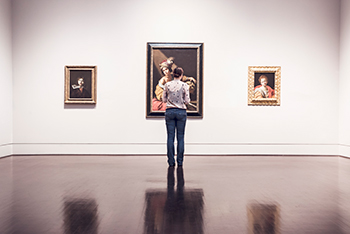 Nothing accounts for taste – as they old saying goes. However, in the modern world art is not only inspiring but also big business. In this episode of The Bottom Line, guests in the art world discuss the relation of art and business. Specifically, how is and should art be valued? Who decides what is and what is not fashionable? Is art just another consumer good to be bought and sold – or does have a more important social role?
Nothing accounts for taste – as they old saying goes. However, in the modern world art is not only inspiring but also big business. In this episode of The Bottom Line, guests in the art world discuss the relation of art and business. Specifically, how is and should art be valued? Who decides what is and what is not fashionable? Is art just another consumer good to be bought and sold – or does have a more important social role?
A significant, but often forgotten, element of art is promotion. The ability to not only create something new and inspiring but also share it with the world. Great artists of the past such as Dali and Warhol were renowned self-promoters. This speaks to the affinities between art and marketing. Namely, the skills needed to properly and effectively market your creations. These skills are perhaps especially relevant for contemporary artists – who must rely on marketing based values of branding in order to succeed in an increasingly competitive artistic market. Kim Lehman and Ian Fills explore this issue in their article “Survive in the Art World: Sell the Brand, Market the Product”
A perhaps just as interesting theme is how art can positively borrow from the finance world. While it is commonly accepted that art must be marketed, its production is traditionally distinguished – at least ideally - from business calculations and practices. However, given the growing funding shortfalls confronting art organizations and artists, perhaps they could learn much from financial paradigms. This includes investing in R and D, “accelerators” and even attracting investors through crowdfunding. Jason Potts investigates the potential of “The New Art of Finance” in his article “Arts Venture Capitalism: Why Demand Drives Better Outcomes”.
Yet it is also necessary to consider the ways that art can spread through processes of market creation. One problem that face many artists is that the art world and taste makers tend to be localized in major cities and metropolitan areas. This means that regional artists are often marginalized while those outside these centers are deprived of a vibrant art culture. Further, it commonly narrows art to the preferences and perspectives of an urbane elite rather then represent the diversity of perspectives in any given time and place. To address these issues, governments have sought to support regional artists. Nevertheless, these attempts can be stymied by lack of funding, lack of public awareness and failure to fully treat regional artists as partners. Additionally, these programs run the risk of turning such art into an exclusively “regional” phenomenon. Public funding, however, can be an effective tool for increasing the influence, sustainability and market for a wide range of “regional” art nationally and internationally. Tracy Callinan covers these themes in depth in her article “What are the Regional Arts and Why do they Matter?”
Businesses are also increasingly relying on art for their success. A number of the world’s largest companies have become some of the art world’s biggest patrons. Corporations such as British Pretroleum and Santos are funding art exhibitions and public culture throughout the world. They claim it as part of their mission as social citizens. Nevertheless, the intentions behind such patronage may not be so innocuous. Instead, corporations use this very public funding of the arts to improve their reputations and thus lessen criticism over their unethical economic and environmental practices. Toby Miller writes of “This friendly face of pollution” in his article “Global Arts Scene Awash with Big Oil and Gas Sponsorship”.
Finally, this raises fundamental questions of what should be the relation of art to markets? True art is commonly thought to be separate from business considerations. Artistic creation should not be corrupted by consumer preferences and the demands of profit. More broadly, art is considered to have profound value to the public beyond its financial worth. They can challenge authority and dominant ideas while inspiring us in ways that cannot be fully captured on a balance sheet. Nonetheless, as has been discussed, the art market is significant. One way to approach this issue is to ascertain economically whether art is a public or private good. A private good is that has rivals and is non-excludable (e.g. if I use it you can’t) whereas a public good has no rivals and can be enjoyed by everyone. The latter often requires public funding due to a lack of sufficient incentives to make it viable for it to be produced at an optimum level for mass consumption. Interestingly, while labeling art a private good obviously has it dangers so too does labeling it a public good have potentially negative costs associated with it. Namely, by not encouraging artists to turn their visions into a marketable good with some sort of mass appeal, you discourage innovation and public relevance. Jason Potts describes this issue in depth in his article “Are the Arts and Culture a Public Good?”
This article was written to accompany the Autumn 2015 series of The Bottom Line. For more information on the series, visit the series page.
Rate and Review
Rate this article
Review this article
Log into OpenLearn to leave reviews and join in the conversation.
Article reviews